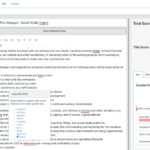Inclusion in corporate America is getting much deserved attention these days. This includes people with disabilities. One of our favorite stories is how companies like Microsoft are employing people with Autism.
We caught up over email with Kelly Hermann, Vice President or Access, Equity & Inclusion at University of Phoenix to get her take on how companies can better meet the needs of their disabled workers.
What do employers need to consider when it comes to offering digital inclusion to employees with disabilities? What are some of the accommodations they may need to make?
KH: Digital inclusion for employees with disabilities means that we have taken the right steps to ensure that everyone can access the content we are sharing. Before a request is even made, we can properly format our documents, use descriptive hyperlinks, write alternative text descriptions for images and graphs, and make sure that videos have transcripts and captions. For example, when working with Microsoft Office documents, content creators can use the built-in style guides to introduce navigation to their documents. This will allow all users to easily skip around the document based on the headings that are most meaningful to them.
Later versions of the Office suite, including Office 365, also have built-in accessibility checkers that allow users to understand where they might have some errors and provide guidance on how to fix them. This helps ensure the current document is accessible but also provides a learning opportunity for the content creator to understand what has to be done when developing similar content. These simple steps let disabled employees know that that the organization has thought of them and included them.
Sometimes, we have to be a little more intentional about ensuring equal access. This may include working with vendors of digital tools and resources through the procurement process to ask about the vendor’s approach to digital accessibility. Questions might include: Have you tested your product for accessibility? Do you use screen readers in testing? How have you included digital accessibility in the product’s road map and future development plans? These questions provide insight into the accessibility of the tool and also communicate your organization’s commitment to digital inclusion.
Outside of the digital content, workplace accommodations will still be what we have traditionally come to expect, in terms of increased flexibility, clarity of expectations, and ergonomic equipment. But it may also include new accommodations in this hybrid work world where more and more of us are remote employees on a part- or full-time basis. Employees might need accommodations to reduce the number of online meetings in a day or for flexible scheduling throughout the day, including split shifts. To name a few, there might also be a need for more intentional synchronous communication between employees and supervisors to clarify expectations, modifications to policies or procedures related to when employees must participate in meetings with their video cameras on, or modifications to the technology in use to ensure that it is compatible with assistive technology devices.
What are the latest tools offering digital inclusion for employees with disabilities?
KH: I think one of the best developments over the last few years has been the increasing use of artificial intelligence and smart devices. These weren’t specifically created to accommodate the disabled, but they make a big difference in their ability to independently manage some of the impact of their disabilities in the same way that many people are managing their lives. Need a reminder to take your medication but are afraid you will forget? Tell Alexa to remind you. It works for both the busy person with too many things to keep track of and for the person with ADHD or short-term memory loss who may lose track of time. Using smart devices has normalized the process of using technology to assist us with tasks.
How has the pandemic and the increased shift to remote and hybrid work created more challenges for disabled workers? Any advice specific to addressing inclusivity issues for remote workers?
KH: I think one of the more challenging aspects of the shift to remote and hybrid work which happened because of the pandemic is now starting to occur as folks start attempting to return to life as it was prior to March of 2020. For years, disabled workers were told it wasn’t possible to have the type of flexibility that became necessary due to the pandemic two years ago. Now that things are shifting back, that flexibility is also starting to go away with the same messages about it not being a reasonable accommodation. I think companies are going to have to think this through and challenge the assumptions about what is a fundamental aspect of their work in a post-pandemic world. If we could pivot because of the threat of an illness, can we continue to offer that same flexibility? It is reasonable to assume that the answer will be no in some cases, but it should also be yes when it can be. And we won’t know for sure until we take a hard look at it.
I think addressing inclusivity for remote workers, especially those with disabilities, requires us to stop and be intentional. We have taken inclusion of folks with disabilities for granted for a long time because there are some long-standing myths that folks with disabilities weren’t able to work. Or if they are able to work, they don’t need much because they can work. There are so many ways that a diagnosis can impact a person, resulting in a need for accommodation. Employers need to ensure that the process of requesting accommodations are visible and straightforward, so employees know how to use the process and communicate their needs. Employers also need to identify areas of opportunity to reduce or remove barriers to full participation, so employees feel included and like they belong. This can be as simple as making sure that their digital content is accessible and paying good attention to the language used to communicate about the needs of employees with disabilities. It can certainly get more complicated but making small, simple changes can often get organizations most of the way there.
How can companies better meet the needs of employees with disabilities? Tips on best practices for setting up a program/plan for inclusivity?
KH: First, look at your processes and procedures for requesting accommodations. Have you made it overly complicated with arduous and stringent documentation requirements that might leave your employees feeling vulnerable and as if they have to share more details of their private lives than they are comfortable sharing? It is important to make sure that your process for getting help doesn’t negate the impact of the help itself.
Second, think about ways in which you can remove barriers to full participation before a request even has to be made. Are you having a live meeting with multiple speakers? Providing captions during that meeting before someone has to ask not only sends a great message about inclusion but also increases communication access which can increase participation. And that’s never a bad thing.
I think most employers are going to find opportunities to improve their access and inclusion for employees with disabilities with these steps, but I also think it is important to ask the employees. Engagement and climate surveys can be great tools to identify opportunities to improve the culture of the organization, especially for those with disabilities. Many times, we rely on data and metrics regarding how many employees are taking advantage of the mechanisms we have set up for them to request accommodations. But how many employees don’t request the accommodations they need because they aren’t comfortable with the process? This is an important data point for overall inclusion and access so we should try to get at that information in order to have a complete picture of how we’re doing.



